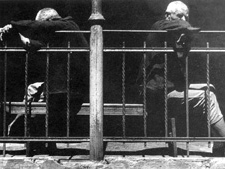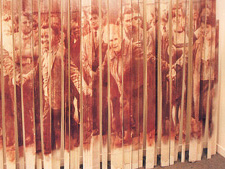Rodrigo
Alonso
 |
|
 |
| Alicia D'Amico. Series Portraits . Black and white photography. 1996. |
 |
Graciela Sacco. Series Body to Body. Heliography on sticks. 270x270 cm. 1996-2000. |
 |
Since its beginnings, photography has been the subject of a debate in which at least two different but not necessarily exclusive concepts of the medium have taken shape.
On the one hand, there is a technical vision of photography that conceives of it primarily as know-how. This knowledge is identifiable in a variety of formal procedures that evidence certain expertise in constructing an image, the search for a precise iconographic translation of its references or the skilful use of the formal devices and techniques that the medium has to offer in its different stages of production (shooting, development and printing).
A second concept of the medium responds to its capacity for creating images, for identifying a frame of the visible universe that offers a new perspective on the world, recuperating inadvertent looks or bringing unusual points of view to their full potential. From this viewpoint, photography is, above all, a know-how-to-see. The photographer's talent is not measured as much according to his/her technical knowledge —although this does not cease to be necessary— but rather for his/her capacity to manifest a vision of the world translated into writing with light.
Both concepts can be found as the basis of multiple theories and opinions on the art of photography. Different formulations can be found both in Pictorialists and Formalists guidelines, in the defense of direct shot or the "decisive moment", in photojournalism or photographic essays practitioners that are based on either one or the other or both of those notions, implicitly or explicitly, with the common aim of clarifying the value that photography holds as an autonomous medium as well as a professional practice.
Furthermore, know-how and know-how-to-see will be the postulates upon which the possible existence of an art of photography can be forged, differing, accordingly, from an everyday practice of photography. Likewise, from these notions a definition of the medium emerges that will enable given uses and forms, relegating others, simultaneously instituting a group of agents that will function as arbiters of photographic production.
As in other parts of the world, photography emerged in Argentina closely related to painting. Beyond the continuity of certain pictorial genres like portrait or landscape in the first photographs, the relation between the two is in general much closer. Some of the first photographers in Argentina came from the realm of painting, such as Juan Camaña (who was the first President of the Society for the Encourage of Fine Arts following its creation in 1876) or Cándido Lopez. The artistic avant-garde circulated in galleries like Witcomb and Van Riel, both of which had photographic studios that were the most important ones of their time. The jury for the First Photographic Competition that was organized by the Photographic Section of the Society for the Encourage of Fine Arts in 1927 was comprised of painters. One year later an orientation course for photography was created within the Superior School of Fine Arts, also directed by painters (1).
It is only with the creation of the first Photo Clubs and the first specialized magazines that the terrain of photography begins to differentiate itself and become more autonomous in relation to the visual arts. The configuration of these spaces was possible due to the appearance of groups of specialists in know-how / know-how-to-see who acted from specific practices and fields. In the first case, the organization of technical courses, competitions and prizes positioned these specialists as shapers of knowledge and as the inspectors of the results; in the second case, it was the editorial boards, equally comprised of specialists, who would rule over the quality of photographic production. This process is clearly verified beginning with the 30s decade and being reinforced in posterior decades.
Nevertheless, the formation of these agencies of legality did not respond only to the need to establish a difference from other visual art creations.
They are also established in consonance and in a vague dialogue with the world of media, in particular, with that of graphic journalism, where images began to circulate indiscriminately. Establishing parameters for the evaluation of photographic production and defining the activity's particularities and scope made it possible to differentiate between those putting certain knowledge into practice and those simply doing their job. As a counterpart, this would facilitate the access of specialized photographers into the world of graphic journalism without losing their status and originality, while in the same movement inserting a certain sector of graphic journalism (that which is articulated along the lines of know-how / know-how-to-see defined earlier) into the circle of consolidated aesthetic photography.
As years passed, photography established itself definitively as an autonomous medium through the labor of photography schools, photo galleries, specialized studios and publications, but also by way of figures who would become references for the medium: Horacio Coppola, Annemarie Heinrich, Humberto Rivas, Grete Stern and later, Alicia D'Amico, Sara Facio, Andy Goldstein or Juan Travnik, to name just a few. All these elements combined to the refinement of a circuit organized around a medium that was increasingly well-defined and configured.
Nonetheless, with the approach of the '80s —with perhaps some precedents in previous years— photography enters into a process that could be called as desdefinition (2). There are multiple factors that determine this process and it may be that many of them are not evident as yet. However, it may be possible to point out a few, even if their incidence today turns out to be partial or fragmentary.
One of the most apparent situations is the renewed relationship between the world of photography and that of the visual arts. In fact, this relationship arises at a moment when the latter are suffering a similar process of desdefinition, which to a great extent transcends that which transfigured them into visual arts some years earlier. This may be the moment when we can actually speak of a field of visual arts, considering that, very much as a contradiction, the expansion of the terrain of fine arts to become visual arts did not seem to include photography, until now (3).
This recovered dialogue generates hybrid spaces, where the difference between one medium and the other become irrelevant or simply formulas. Studies and histories of recent art no longer position photography in its own section or chapter, just as a history of recent photography would not be able to deny the inclusion of artists whose backgrounds are in other visual disciplines, without resulting incomplete or partisan. In the same way, just as art museums and galleries no longer differentiate between photographic production by artists whose formation has been either in photography or in visual arts, the same thing happens in spaces traditionally destined for photographers, such as photo galleries, or in events as specific as the Festival de la Luz. To the growing interrelation between these previously separate areas are added a series of factors specific to each field that may have favored their integration.
In the realm of photography, some artists seem to treat the medium with less solemnity than their predecessors. This is evident in actions such as scratching negatives (Julie Weiss), chromatic manipulation (Marcos Lopez) or graphic manipulation (Gabriel Valansi) of images, the device of staging scenes (Lopez), and orientation toward unorthodox forms of using photographic material or of taking photographs (Esteban Pastorino). Others seem to take the supremacy of the reference in relative terms in order to construct introspective visions (Juan Travnik), at times resorting to techniques or procedures that aim toward the estrangement of the object of the shot (Ignacio Iasparra), even to the point of negating it (Paula Grandio).
It may be a stretch to postulate a few hypotheses, but the impact that the growing presence of advertising photography (which many of the above-mentioned artists practice or have practiced) has had on photographic activity may not have been all that bad, just as, in more general terms, the constant manipulation of images propitiated by the graphic media and digital technology (which is the basis of a large portion of the theories about simulacrum, equally popular during the eighties).
Advertising production encourages the creation of a cosmetic world, where the portrayed object cedes to the impact of manipulations and effects posterior to the instant the shot is taken. There is a strong contrast between its artificiality and the search for authenticity or the exaltation of the portrayed object claimed by objective photography, rooted in photography's traditions. In advertising imagery, it is not the object that is the focal point of interest but the symbolism that it triggers, which is, to a large degree, the result of the technical makeup that envelops it. This artificiality is equally separate from the authenticity and narrative base of photojournalism and photo-graphic essays: at times by way of an auto-referentiality that negates any possibility of narrative; at others, through the construction of a strongly superimposed discourse that does not hide distortions and manipulations (like that which slips out in Marcos Lopez's recent work, in publicity as well as in the visual arts).
On the visual artists’ side, photography introduces a renewed interest in representation, following a period in which conceptualism had displaced images, leaning more towards investigations in linguistics and discourse. Neoconceptualism in the '80s recovered the importance of images, reorienting interest in discourse toward the realm of mass media, where the photo-graphic images take on greater focus. Dino Bruzzone's work explores this aspect, mainly in his reconstructions of journalistic images.
This procedure introduces one of the key preferences held by artists who approach photography from the visual arts, at least clearly during the nineties. In these cases, photography frequently acquires a utilitarian aspect. This approach to the medium is defined by a know-how-to-use. This is how Leonel Luna builds his particular versions of historic Argentinean iconography, or how Martin Bonadeo transposes a landscape onto an exhibition environment; it is how Gabriela Fernandez elaborates impossible reflections or Marcela Mouján produces photographic portraits or imprints of nature that are no less unreal. Certain historic formal photographic procedures recuperated can be thought of in a similar way, like photograms in Andrea Ostera's work or heliography in Graciela Sacco's work.
In the case of some artists, it seems almost inappropriate to say that they take photographs. Their production can be better described by the term photographic practice. Clear examples of this would be the series of work on the Conquest of the Desert by RES, or the multiple series on objects by Raúl Flores. These groups of works shape a tendency that is common in art from the nineties, that was barely seen in Argentinean artists during that time but that seems to have increased toward the beginning of the following decade: the recovery of a sense of process in artistic practice, that artists had discovered in the sixties and seventies, accompanied by photography to a great extent.
Thirty years later, the alliance is renewed, perhaps in a more lasting way. The benefits are not insignificant. Following a century of precarious definitions and ambiguous relations, the visual arts would seem to be uniting once again, revising pacts and breaking down boundaries.
|
Published in:
Territorios Ocupados (cat.). Buenos Aires: Fundación
Espacio Telefónica, 2004.
NotEs
(1) For a panorama of photogra-phy’s history in Argentina see Sara Facio. La Fotografía en Argentina. Desde 1840 a Nuestros Días. Buenos Aires: La Azotea, 1995.
(2) In order not to abuse the word deconstruction, I prefer to use the less philosophic over-determined term desdefinition.
(3) Numerous cases exist of authors who differentiate between photography and visual arts. See, for example, Eric Hobsbawm. Behind the Times. New York: Times & Hudson, 1999.
|

